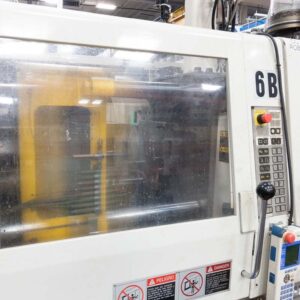December 03, 2018
3 Tips for Calculating Press Size | Plastic Injection Mold
Are you a product designer or engineer that is looking for more information on how to make your plastic part design more efficient in regard to cost and production time? One important consideration during the part design process is to have a good understanding of plastic injection press basics including the size of machine needed for your part.
“Bigger the better” is not always the case when determining the press size needed. In the molding process, plastic is injected into the mold at an exceptionally high-pressure rate, which creates a natural pull to force the mold open. A press is designed to keep the mold shut with larger parts requiring more tonnage and force, and smaller parts requiring less. A general calculation for determining press size needed is as follows:
Pressure (lb/in2) x Projected Area (in2) = Force (lb.)
Here are a few other important tips for calculating the right press size for your plastic injection molded part.
1. Understand press size tonnage.
Your plastic injection molder should help you determine the size of the machine needed to help you achieve the best result for your product. Knowing an approximate size of what will be needed can help you determine the best injection molding partner based on the press capacity they have available. For example, larger presses cannot accommodate smaller molds because they can’t close far enough and the injection process will not work.
Additionally, smaller presses have tie bar spacing too narrow to accommodate larger products. If the mold doesn’t fit between them horizontally or vertically, you must move up in press size. Many injection molders offer press sizes ranging from 68 tons up to 400 tons.
2. Calculate your total projected shut-off area and shot volume.
When determining press size for your plastic part, it’s important to calculate the total projected shut-off area. This area consists of only the space that is 90 degrees to the direction of the injection molding machine platens. Thickness does not have any implication on the clamp tonnage and the general rule is to have 2 to 5 ton of clamp tonnage per square inch of projected area.
Calculating shot volume to make sure your barrel has enough capacity can be accomplished by working with your injection molder to run a mold flow analysis. On some engineered materials, the increased residence of the material in the barrel can cause the material to degrade, resulting in poor part quality. Mold flow analysis will help you determine the volume of your part and runner while determining any factors that would cause safety issues.
3. Know how much clamping force or pressure is required.
Pressure plays a significant role in the overall quality of a plastic part. Pressure keeps the mold closed during the injection process. Too much or too little pressure can cause various issues such as flashing and viscosity. One important consideration in regard to pressure is that plastic compounds react differently from one another based on their Melt Flow Index (MFI). MFI measures the ease of flow of a thermoplastic polymer and the higher the MFI, the higher pressure needed to create a successful part.
“Safety factor” is an additional percentage added to your calculation as a buffer to help reduce defects in your part. Most injection molders will recommend 2.5 times the surface square inches of the part and an additional 10% as a safety factor. If you have a part that is 120 square inches, you would need a press size with 300 tons of pressure. When you add the 10% safety factor, the required press size would have 330 tons of clamping force.
Having a general understanding of how to calculate press size is a good first step in determining what injection molding partners are available to you. Strong partners will make recommendations on how to appropriately tweak your part to ensure the final design fits your manufacturing needs and reduces upfront tooling costs. Nicolet Plastics has press sizes up to 610 tons.
